Attached files
| file | filename |
|---|---|
| 8-K - FORM 8-K - ENDURANCE SPECIALTY HOLDINGS LTD | c24838e8vk.htm |
Exhibit 99.1
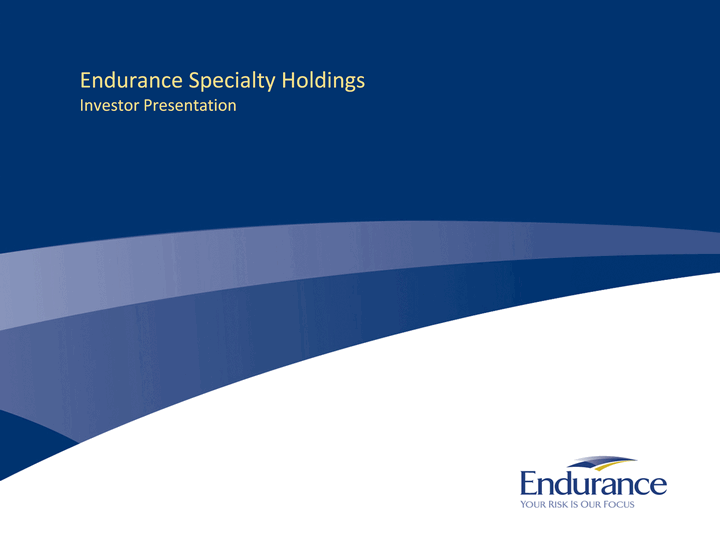
| Endurance Specialty Holdings Investor Presentation |
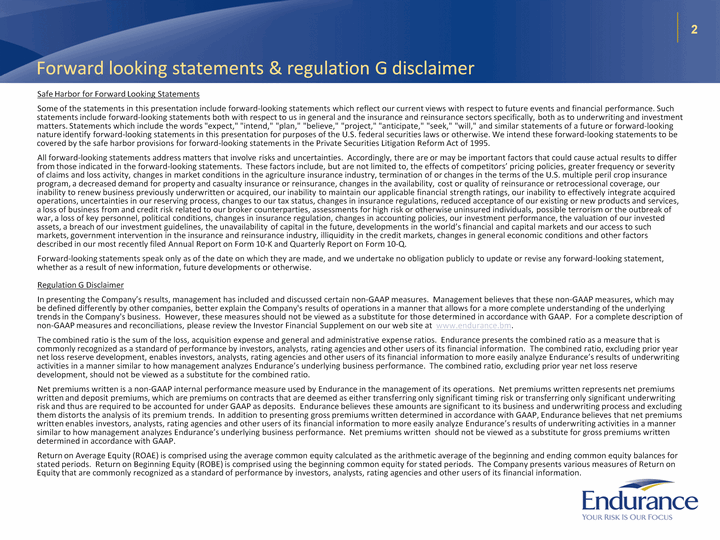
| Forward looking statements & regulation G disclaimer Safe Harbor for Forward Looking Statements Some of the statements in this presentation include forward-looking statements which reflect our current views with respect to future events and financial performance. Such statements include forward-looking statements both with respect to us in general and the insurance and reinsurance sectors specifically, both as to underwriting and investment matters. Statements which include the words "expect," "intend," "plan," "believe," "project," "anticipate," "seek," "will," and similar statements of a future or forward-looking nature identify forward-looking statements in this presentation for purposes of the U.S. federal securities laws or otherwise. We intend these forward-looking statements to be covered by the safe harbor provisions for forward-looking statements in the Private Securities Litigation Reform Act of 1995. All forward-looking statements address matters that involve risks and uncertainties. Accordingly, there are or may be important factors that could cause actual results to differ from those indicated in the forward-looking statements. These factors include, but are not limited to, the effects of competitors' pricing policies, greater frequency or severity of claims and loss activity, changes in market conditions in the agriculture insurance industry, termination of or changes in the terms of the U.S. multiple peril crop insurance program, a decreased demand for property and casualty insurance or reinsurance, changes in the availability, cost or quality of reinsurance or retrocessional coverage, our inability to renew business previously underwritten or acquired, our inability to maintain our applicable financial strength ratings, our inability to effectively integrate acquired operations, uncertainties in our reserving process, changes to our tax status, changes in insurance regulations, reduced acceptance of our existing or new products and services, a loss of business from and credit risk related to our broker counterparties, assessments for high risk or otherwise uninsured individuals, possible terrorism or the outbreak of war, a loss of key personnel, political conditions, changes in insurance regulation, changes in accounting policies, our investment performance, the valuation of our invested assets, a breach of our investment guidelines, the unavailability of capital in the future, developments in the world's financial and capital markets and our access to such markets, government intervention in the insurance and reinsurance industry, illiquidity in the credit markets, changes in general economic conditions and other factors described in our most recently filed Annual Report on Form 10-K and Quarterly Report on Form 10-Q. Forward-looking statements speak only as of the date on which they are made, and we undertake no obligation publicly to update or revise any forward-looking statement, whether as a result of new information, future developments or otherwise. Regulation G Disclaimer In presenting the Company's results, management has included and discussed certain non-GAAP measures. Management believes that these non-GAAP measures, which may be defined differently by other companies, better explain the Company's results of operations in a manner that allows for a more complete understanding of the underlying trends in the Company's business. However, these measures should not be viewed as a substitute for those determined in accordance with GAAP. For a complete description of non-GAAP measures and reconciliations, please review the Investor Financial Supplement on our web site at www.endurance.bm. The combined ratio is the sum of the loss, acquisition expense and general and administrative expense ratios. Endurance presents the combined ratio as a measure that is commonly recognized as a standard of performance by investors, analysts, rating agencies and other users of its financial information. The combined ratio, excluding prior year net loss reserve development, enables investors, analysts, rating agencies and other users of its financial information to more easily analyze Endurance's results of underwriting activities in a manner similar to how management analyzes Endurance's underlying business performance. The combined ratio, excluding prior year net loss reserve development, should not be viewed as a substitute for the combined ratio. Net premiums written is a non-GAAP internal performance measure used by Endurance in the management of its operations. Net premiums written represents net premiums written and deposit premiums, which are premiums on contracts that are deemed as either transferring only significant timing risk or transferring only significant underwriting risk and thus are required to be accounted for under GAAP as deposits. Endurance believes these amounts are significant to its business and underwriting process and excluding them distorts the analysis of its premium trends. In addition to presenting gross premiums written determined in accordance with GAAP, Endurance believes that net premiums written enables investors, analysts, rating agencies and other users of its financial information to more easily analyze Endurance's results of underwriting activities in a manner similar to how management analyzes Endurance's underlying business performance. Net premiums written should not be viewed as a substitute for gross premiums written determined in accordance with GAAP. Return on Average Equity (ROAE) is comprised using the average common equity calculated as the arithmetic average of the beginning and ending common equity balances for stated periods. Return on Beginning Equity (ROBE) is comprised using the beginning common equity for stated periods. The Company presents various measures of Return on Equity that are commonly recognized as a standard of performance by investors, analysts, rating agencies and other users of its financial information. 2 |
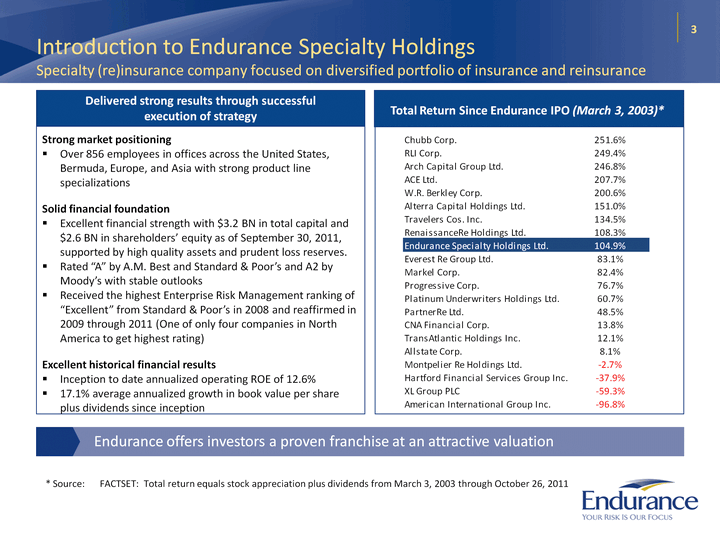
| 3 Introduction to Endurance Specialty Holdings Specialty (re)insurance company focused on diversified portfolio of insurance and reinsurance Strong market positioning Over 856 employees in offices across the United States, Bermuda, Europe, and Asia with strong product line specializations Solid financial foundation Excellent financial strength with $3.2 BN in total capital and $2.6 BN in shareholders' equity as of September 30, 2011, supported by high quality assets and prudent loss reserves. Rated "A" by A.M. Best and Standard & Poor's and A2 by Moody's with stable outlooks Received the highest Enterprise Risk Management ranking of "Excellent" from Standard & Poor's in 2008 and reaffirmed in 2009 through 2011 (One of only four companies in North America to get highest rating) Excellent historical financial results Inception to date annualized operating ROE of 12.6% 17.1% average annualized growth in book value per share plus dividends since inception Delivered strong results through successful execution of strategy Total Return Since Endurance IPO (March 3, 2003)* * Source: FACTSET: Total return equals stock appreciation plus dividends from March 3, 2003 through October 26, 2011 Endurance offers investors a proven franchise at an attractive valuation |

| 4 Specialty Focused, Diversified Portfolio of Businesses Portfolio diversified by product, distribution source and geography Trailing Twelve Months Net Premiums Written as of September 30, 2011: $1.95 BN Reinsurance - by Geographic Market Insurance - by Distribution Source Agriculture Personal Accident Surety Casualty & Workers' Compensation Professional Liability Property Per Risk Small Business Direct Treaty Aerospace Casualty Clash International Property Catastrophe US Property Catastrophe Workers' Compensation Catastrophe ARMtech Agriculture US Property US Casualty US Miscellaneous E&O Healthcare Excess Casualty Professional Lines Habitational Environmental International 6% E R S Fortune 1000 9% Middle Market 8% Bermuda 21% Americas 22% Program 4% Casualty Marine Motor Personal Accident Professional Indemnity Property Surety Trade Credit Small Risk 30% Independent Agents Brokers Wholesale Managing General Agents |
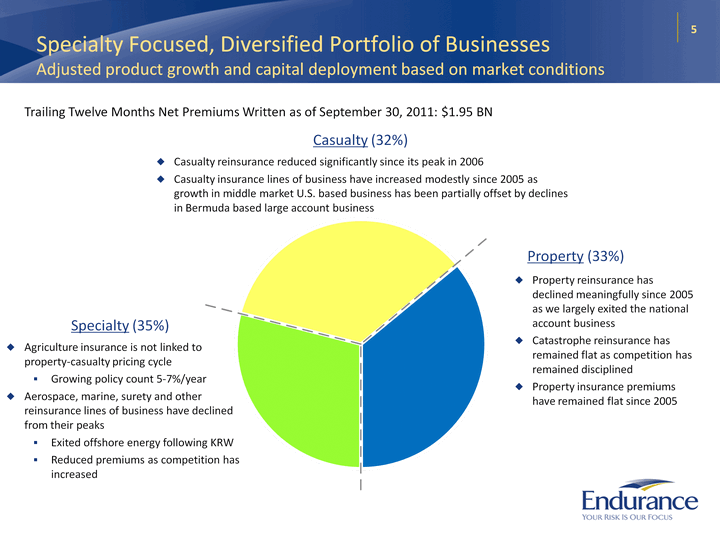
| 5 Specialty Focused, Diversified Portfolio of Businesses Adjusted product growth and capital deployment based on market conditions Trailing Twelve Months Net Premiums Written as of September 30, 2011: $1.95 BN Property (33%) Casualty (32%) Property reinsurance has declined meaningfully since 2005 as we largely exited the national account business Catastrophe reinsurance has remained flat as competition has remained disciplined Property insurance premiums have remained flat since 2005 Agriculture insurance is not linked to property-casualty pricing cycle Growing policy count 5-7%/year Aerospace, marine, surety and other reinsurance lines of business have declined from their peaks Exited offshore energy following KRW Reduced premiums as competition has increased Specialty (35%) Casualty reinsurance reduced significantly since its peak in 2006 Casualty insurance lines of business have increased modestly since 2005 as growth in middle market U.S. based business has been partially offset by declines in Bermuda based large account business |
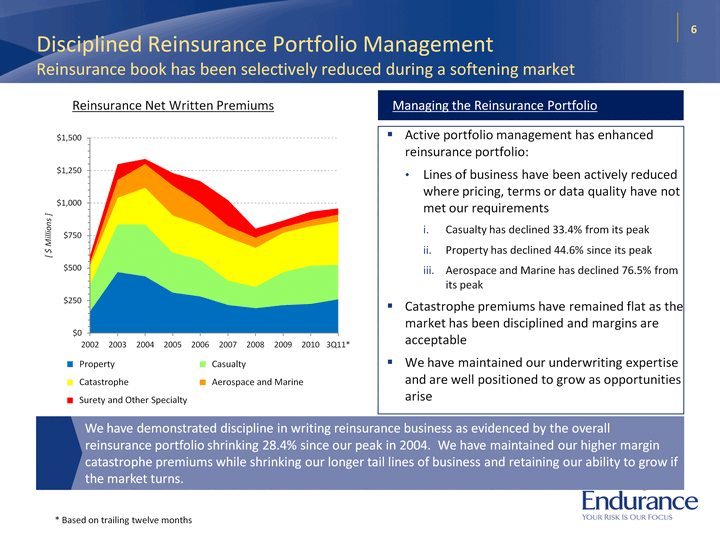
| Disciplined Reinsurance Portfolio Management Reinsurance book has been selectively reduced during a softening market Reinsurance Net Written Premiums Reinsurance Net Written Premiums Managing the Reinsurance Portfolio 6 We have demonstrated discipline in writing reinsurance business as evidenced by the overall reinsurance portfolio shrinking 28.4% since our peak in 2004. We have maintained our higher margin catastrophe premiums while shrinking our longer tail lines of business and retaining our ability to grow if the market turns. Active portfolio management has enhanced reinsurance portfolio: Lines of business have been actively reduced where pricing, terms or data quality have not met our requirements Casualty has declined 33.4% from its peak Property has declined 44.6% since its peak Aerospace and Marine has declined 76.5% from its peak Catastrophe premiums have remained flat as the market has been disciplined and margins are acceptable We have maintained our underwriting expertise and are well positioned to grow as opportunities arise * Based on trailing twelve months |
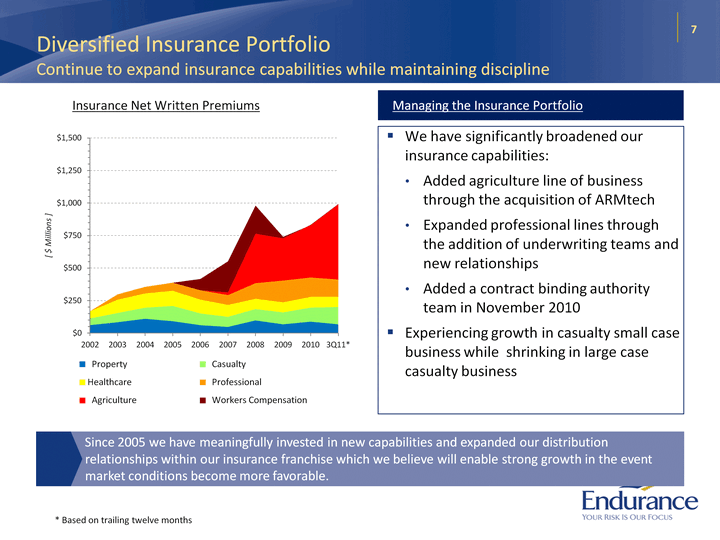
| Diversified Insurance Portfolio Continue to expand insurance capabilities while maintaining discipline Insurance Net Written Premiums Insurance Net Written Premiums Managing the Insurance Portfolio 7 Since 2005 we have meaningfully invested in new capabilities and expanded our distribution relationships within our insurance franchise which we believe will enable strong growth in the event market conditions become more favorable. We have significantly broadened our insurance capabilities: Added agriculture line of business through the acquisition of ARMtech Expanded professional lines through the addition of underwriting teams and new relationships Added a contract binding authority team in November 2010 Experiencing growth in casualty small case business while shrinking in large case casualty business * Based on trailing twelve months |
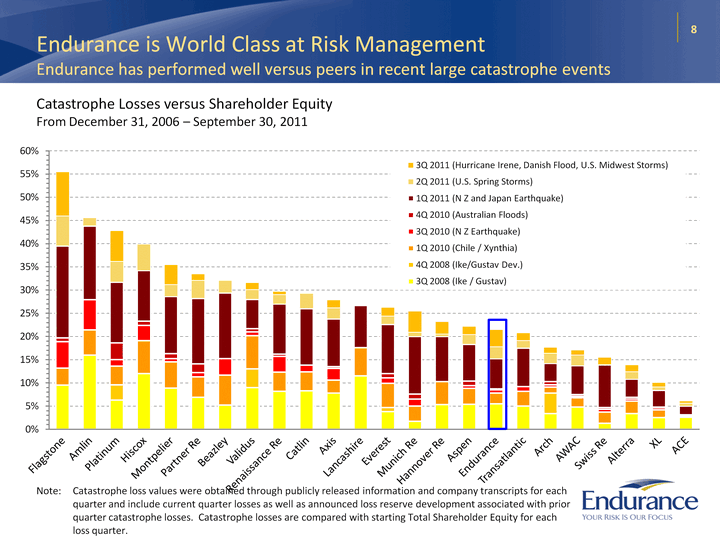
| Endurance is World Class at Risk Management Endurance has performed well versus peers in recent large catastrophe events 8 Catastrophe Losses versus Shareholder Equity From December 31, 2006 - September 30, 2011 (CHART) Note: Catastrophe loss values were obtained through publicly released information and company transcripts for each quarter and include current quarter losses as well as announced loss reserve development associated with prior quarter catastrophe losses. Catastrophe losses are compared with starting Total Shareholder Equity for each loss quarter. |
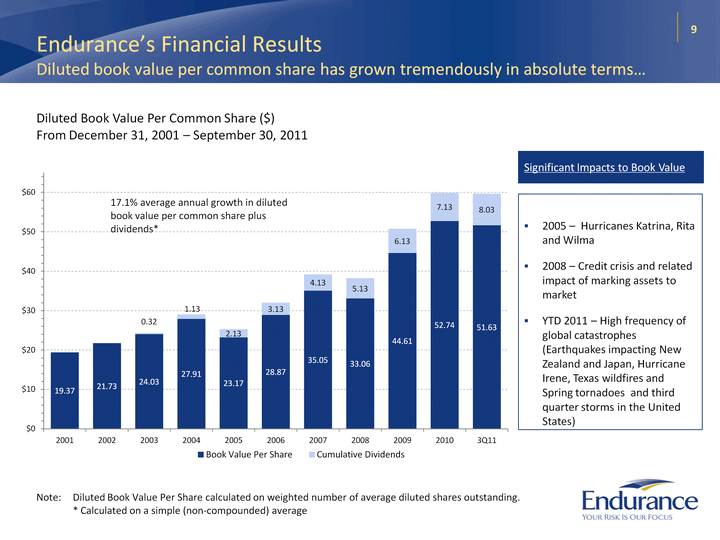
| (CHART) 9 Endurance's Financial Results Diluted book value per common share has grown tremendously in absolute terms... Diluted Book Value Per Common Share ($) From December 31, 2001 - September 30, 2011 Note: Diluted Book Value Per Share calculated on weighted number of average diluted shares outstanding. * Calculated on a simple (non-compounded) average 17.1% average annual growth in diluted book value per common share plus dividends* 2005 - Hurricanes Katrina, Rita and Wilma 2008 - Credit crisis and related impact of marking assets to market YTD 2011 - High frequency of global catastrophes (Earthquakes impacting New Zealand and Japan, Hurricane Irene, Texas wildfires and Spring tornadoes and third quarter storms in the United States) Significant Impacts to Book Value |

| Endurance's Financial Results Book value per common share has also grown significantly versus peers 10 Fully Diluted Book Value Per Share Plus Dividend Growth From December 31, 2006 - September 30, 2011 (CHART) Note: Fully Diluted Book value per share and dividend data provided by company press releases and filings. For those companies that do not disclose fully diluted book value per share, the dilution was calculated using average diluted shares outstanding. |
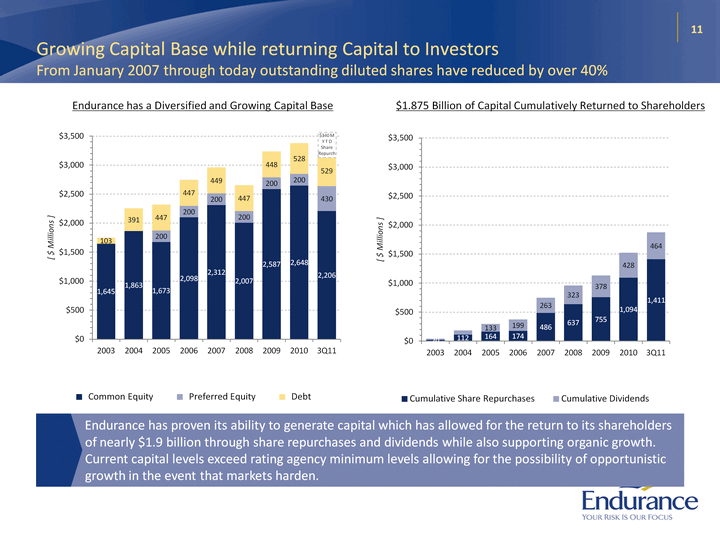
| Growing Capital Base while returning Capital to Investors From January 2007 through today outstanding diluted shares have reduced by over 40% Endurance has a Diversified and Growing Capital Base Endurance has a Diversified and Growing Capital Base $1.875 Billion of Capital Cumulatively Returned to Shareholders 11 Endurance has proven its ability to generate capital which has allowed for the return to its shareholders of nearly $1.9 billion through share repurchases and dividends while also supporting organic growth. Current capital levels exceed rating agency minimum levels allowing for the possibility of opportunistic growth in the event that markets harden. |
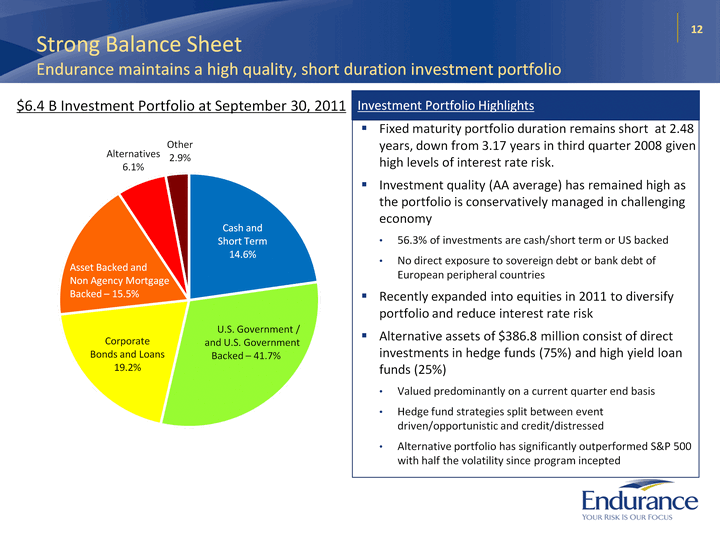
| Strong Balance Sheet Endurance maintains a high quality, short duration investment portfolio $6.4 B Investment Portfolio at September 30, 2011 Investment Portfolio Highlights Fixed maturity portfolio duration remains short at 2.48 years, down from 3.17 years in third quarter 2008 given high levels of interest rate risk. Investment quality (AA average) has remained high as the portfolio is conservatively managed in challenging economy 56.3% of investments are cash/short term or US backed No direct exposure to sovereign debt or bank debt of European peripheral countries Recently expanded into equities in 2011 to diversify portfolio and reduce interest rate risk Alternative assets of $386.8 million consist of direct investments in hedge funds (75%) and high yield loan funds (25%) Valued predominantly on a current quarter end basis Hedge fund strategies split between event driven/opportunistic and credit/distressed Alternative portfolio has significantly outperformed S&P 500 with half the volatility since program incepted 12 Cash and Short Term 14.6% U.S. Government / and U.S. Government Backed - 41.7% Other 2.9% Alternatives 6.1% Asset Backed and Non Agency Mortgage Backed - 15.5% Corporate Bonds and Loans 19.2% |
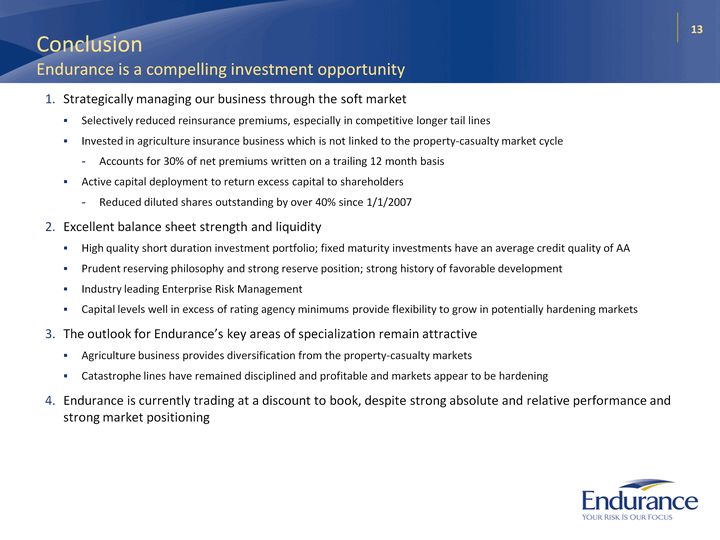
| Conclusion Endurance is a compelling investment opportunity Strategically managing our business through the soft market Selectively reduced reinsurance premiums, especially in competitive longer tail lines Invested in agriculture insurance business which is not linked to the property-casualty market cycle Accounts for 30% of net premiums written on a trailing 12 month basis Active capital deployment to return excess capital to shareholders Reduced diluted shares outstanding by over 40% since 1/1/2007 Excellent balance sheet strength and liquidity High quality short duration investment portfolio; fixed maturity investments have an average credit quality of AA Prudent reserving philosophy and strong reserve position; strong history of favorable development Industry leading Enterprise Risk Management Capital levels well in excess of rating agency minimums provide flexibility to grow in potentially hardening markets The outlook for Endurance's key areas of specialization remain attractive Agriculture business provides diversification from the property-casualty markets Catastrophe lines have remained disciplined and profitable and markets appear to be hardening Endurance is currently trading at a discount to book, despite strong absolute and relative performance and strong market positioning 13 |
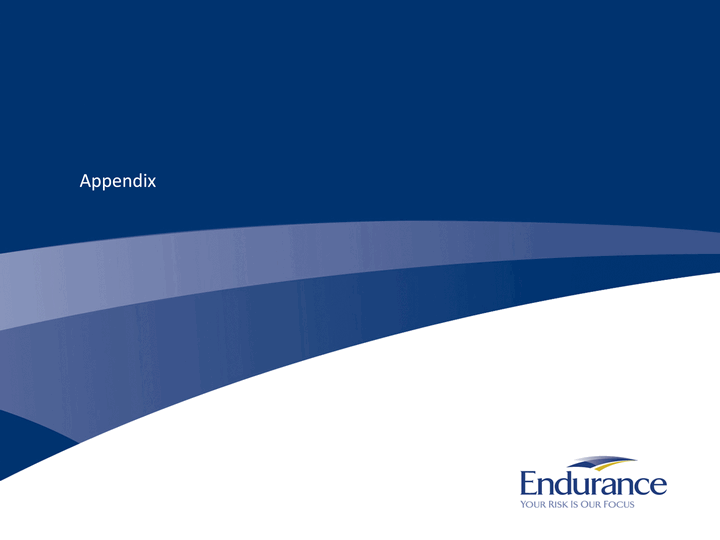
| Appendix |
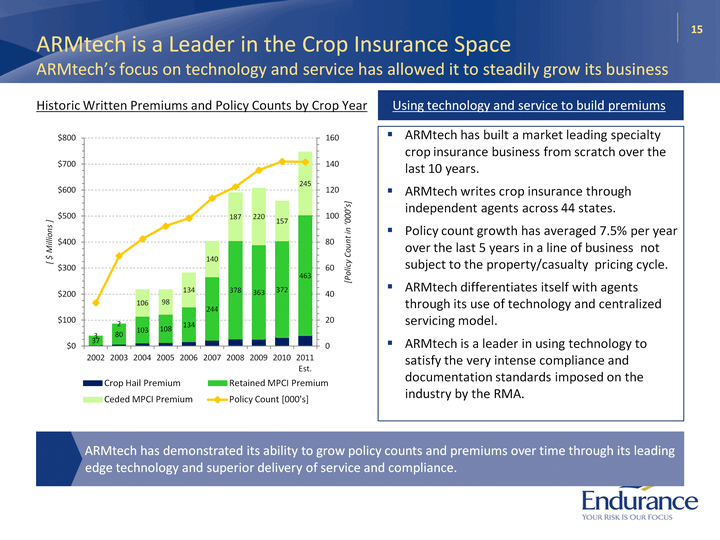
| ARMtech is a Leader in the Crop Insurance Space ARMtech's focus on technology and service has allowed it to steadily grow its business Historic Written Premiums and Policy Counts by Crop Year Historic Written Premiums and Policy Counts by Crop Year Using technology and service to build premiums 15 ARMtech has demonstrated its ability to grow policy counts and premiums over time through its leading edge technology and superior delivery of service and compliance. ARMtech has built a market leading specialty crop insurance business from scratch over the last 10 years. ARMtech writes crop insurance through independent agents across 44 states. Policy count growth has averaged 7.5% per year over the last 5 years in a line of business not subject to the property/casualty pricing cycle. ARMtech differentiates itself with agents through its use of technology and centralized servicing model. ARMtech is a leader in using technology to satisfy the very intense compliance and documentation standards imposed on the industry by the RMA. |
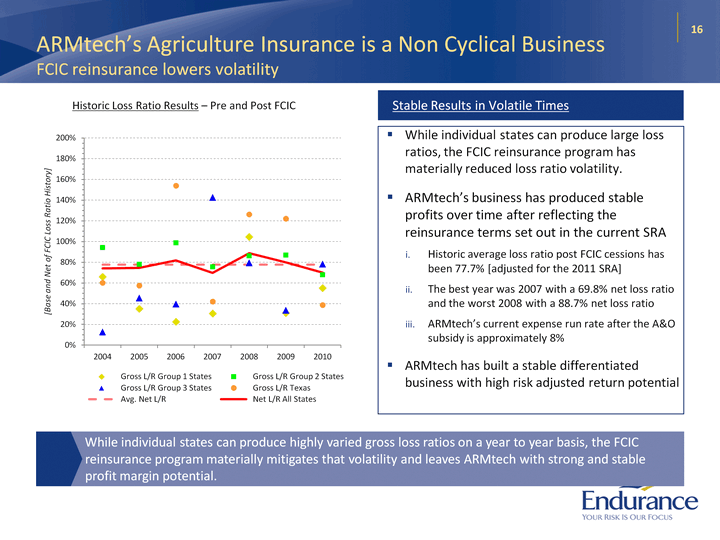
| ARMtech's Agriculture Insurance is a Non Cyclical Business FCIC reinsurance lowers volatility Historic Loss Ratio Results - Pre and Post FCIC Historic Loss Ratio Results - Pre and Post FCIC Stable Results in Volatile Times 16 While individual states can produce highly varied gross loss ratios on a year to year basis, the FCIC reinsurance program materially mitigates that volatility and leaves ARMtech with strong and stable profit margin potential. While individual states can produce large loss ratios, the FCIC reinsurance program has materially reduced loss ratio volatility. ARMtech's business has produced stable profits over time after reflecting the reinsurance terms set out in the current SRA Historic average loss ratio post FCIC cessions has been 77.7% [adjusted for the 2011 SRA] The best year was 2007 with a 69.8% net loss ratio and the worst 2008 with a 88.7% net loss ratio ARMtech's current expense run rate after the A&O subsidy is approximately 8% ARMtech has built a stable differentiated business with high risk adjusted return potential |
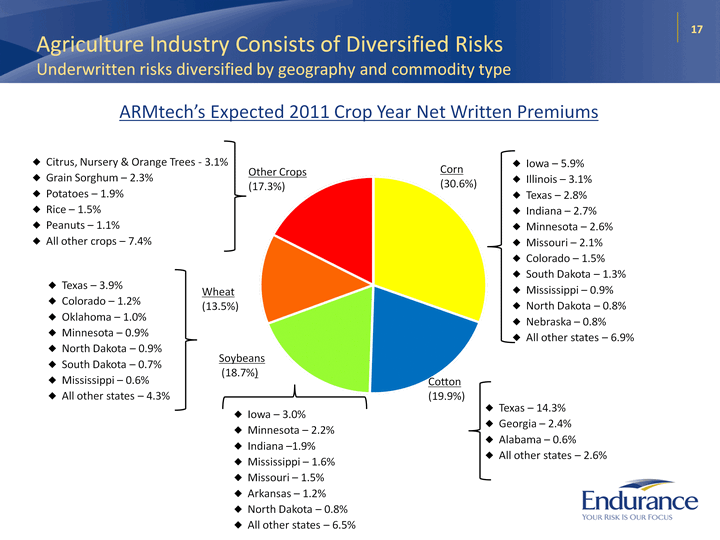
| 17 Agriculture Industry Consists of Diversified Risks Underwritten risks diversified by geography and commodity type ARMtech's Expected 2011 Crop Year Net Written Premiums Iowa - 5.9% Illinois - 3.1% Texas - 2.8% Indiana - 2.7% Minnesota - 2.6% Missouri - 2.1% Colorado - 1.5% South Dakota - 1.3% Mississippi - 0.9% North Dakota - 0.8% Nebraska - 0.8% All other states - 6.9% Corn (30.6%) Texas - 14.3% Georgia - 2.4% Alabama - 0.6% All other states - 2.6% Cotton (19.9%) Iowa - 3.0% Minnesota - 2.2% Indiana -1.9% Mississippi - 1.6% Missouri - 1.5% Arkansas - 1.2% North Dakota - 0.8% All other states - 6.5% Soybeans (18.7%) Other Crops (17.3%) Wheat (13.5%) Texas - 3.9% Colorado - 1.2% Oklahoma - 1.0% Minnesota - 0.9% North Dakota - 0.9% South Dakota - 0.7% Mississippi - 0.6% All other states - 4.3% Citrus, Nursery & Orange Trees - 3.1% Grain Sorghum - 2.3% Potatoes - 1.9% Rice - 1.5% Peanuts - 1.1% All other crops - 7.4% |
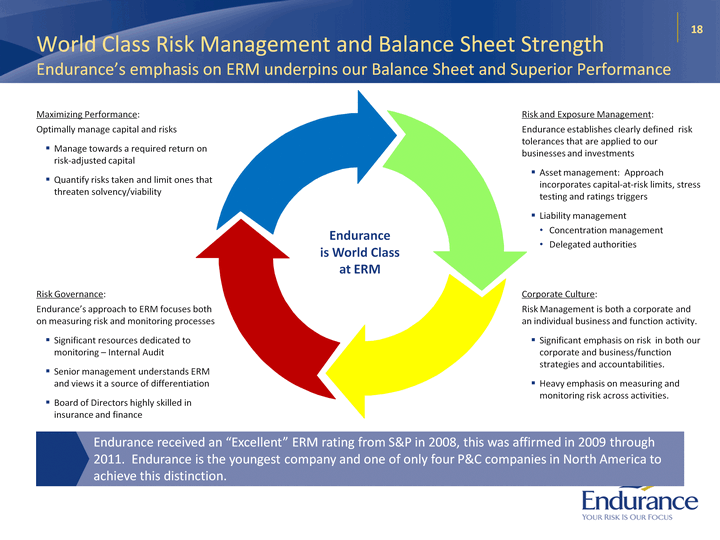
| 18 World Class Risk Management and Balance Sheet Strength Endurance's emphasis on ERM underpins our Balance Sheet and Superior Performance Endurance is World Class at ERM Risk and Exposure Management: Endurance establishes clearly defined risk tolerances that are applied to our businesses and investments Asset management: Approach incorporates capital-at-risk limits, stress testing and ratings triggers Liability management Concentration management Delegated authorities Corporate Culture: Risk Management is both a corporate and an individual business and function activity. Significant emphasis on risk in both our corporate and business/function strategies and accountabilities. Heavy emphasis on measuring and monitoring risk across activities. Risk Governance: Endurance's approach to ERM focuses both on measuring risk and monitoring processes Significant resources dedicated to monitoring - Internal Audit Senior management understands ERM and views it a source of differentiation Board of Directors highly skilled in insurance and finance Maximizing Performance: Optimally manage capital and risks Manage towards a required return on risk-adjusted capital Quantify risks taken and limit ones that threaten solvency/viability Endurance received an "Excellent" ERM rating from S&P in 2008, this was affirmed in 2009 through 2011. Endurance is the youngest company and one of only four P&C companies in North America to achieve this distinction. |
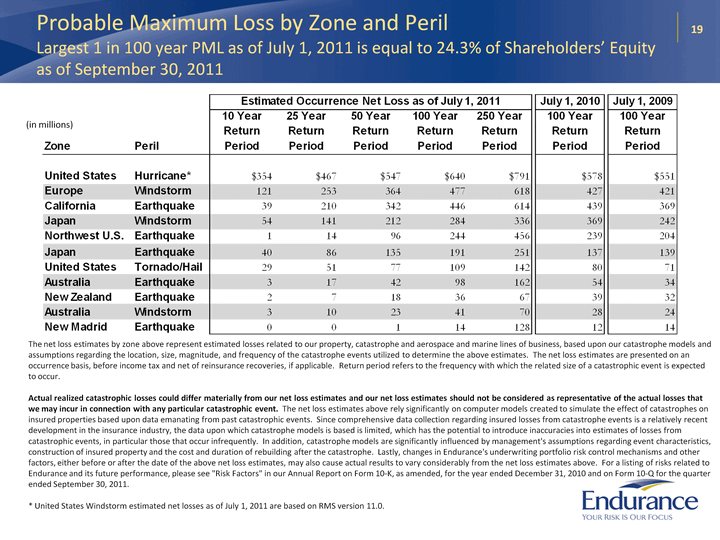
| 19 Probable Maximum Loss by Zone and Peril Largest 1 in 100 year PML as of July 1, 2011 is equal to 24.3% of Shareholders' Equity as of September 30, 2011 The net loss estimates by zone above represent estimated losses related to our property, catastrophe and aerospace and marine lines of business, based upon our catastrophe models and assumptions regarding the location, size, magnitude, and frequency of the catastrophe events utilized to determine the above estimates. The net loss estimates are presented on an occurrence basis, before income tax and net of reinsurance recoveries, if applicable. Return period refers to the frequency with which the related size of a catastrophic event is expected to occur. Actual realized catastrophic losses could differ materially from our net loss estimates and our net loss estimates should not be considered as representative of the actual losses that we may incur in connection with any particular catastrophic event. The net loss estimates above rely significantly on computer models created to simulate the effect of catastrophes on insured properties based upon data emanating from past catastrophic events. Since comprehensive data collection regarding insured losses from catastrophe events is a relatively recent development in the insurance industry, the data upon which catastrophe models is based is limited, which has the potential to introduce inaccuracies into estimates of losses from catastrophic events, in particular those that occur infrequently. In addition, catastrophe models are significantly influenced by management's assumptions regarding event characteristics, construction of insured property and the cost and duration of rebuilding after the catastrophe. Lastly, changes in Endurance's underwriting portfolio risk control mechanisms and other factors, either before or after the date of the above net loss estimates, may also cause actual results to vary considerably from the net loss estimates above. For a listing of risks related to Endurance and its future performance, please see "Risk Factors" in our Annual Report on Form 10-K, as amended, for the year ended December 31, 2010 and on Form 10-Q for the quarter ended September 30, 2011. * United States Windstorm estimated net losses as of July 1, 2011 are based on RMS version 11.0. (in millions) |
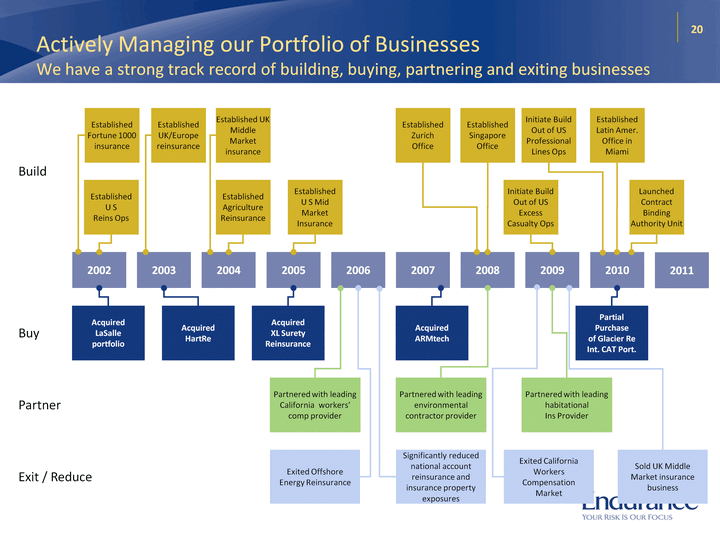
| 2011 2008 2006 2002 2003 2004 2005 2007 2009 2010 20 Actively Managing our Portfolio of Businesses We have a strong track record of building, buying, partnering and exiting businesses Buy Build Partner Acquired LaSalle portfolio Acquired HartRe Acquired ARMtech Partnered with leading California workers' comp provider Acquired XL Surety Reinsurance Established U S Reins Ops Established UK/Europe reinsurance Established Fortune 1000 insurance Established UK Middle Market insurance Established U S Mid Market Insurance Established Agriculture Reinsurance Partnered with leading environmental contractor provider Partnered with leading habitational Ins Provider Established Singapore Office Established Zurich Office Partial Purchase of Glacier Re Int. CAT Port. Initiate Build Out of US Excess Casualty Ops Initiate Build Out of US Professional Lines Ops Established Latin Amer. Office in Miami Launched Contract Binding Authority Unit Exit / Reduce Exited Offshore Energy Reinsurance Significantly reduced national account reinsurance and insurance property exposures Exited California Workers Compensation Market Sold UK Middle Market insurance business |
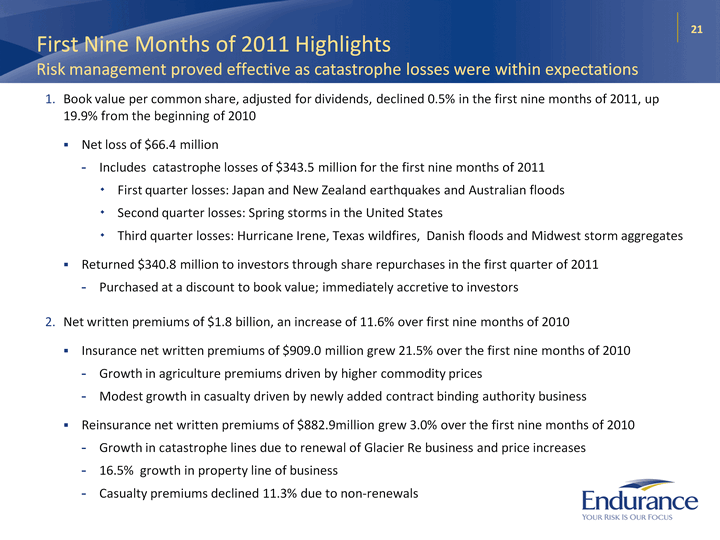
| First Nine Months of 2011 Highlights Risk management proved effective as catastrophe losses were within expectations Book value per common share, adjusted for dividends, declined 0.5% in the first nine months of 2011, up 19.9% from the beginning of 2010 Net loss of $66.4 million Includes catastrophe losses of $343.5 million for the first nine months of 2011 First quarter losses: Japan and New Zealand earthquakes and Australian floods Second quarter losses: Spring storms in the United States Third quarter losses: Hurricane Irene, Texas wildfires, Danish floods and Midwest storm aggregates Returned $340.8 million to investors through share repurchases in the first quarter of 2011 Purchased at a discount to book value; immediately accretive to investors Net written premiums of $1.8 billion, an increase of 11.6% over first nine months of 2010 Insurance net written premiums of $909.0 million grew 21.5% over the first nine months of 2010 Growth in agriculture premiums driven by higher commodity prices Modest growth in casualty driven by newly added contract binding authority business Reinsurance net written premiums of $882.9million grew 3.0% over the first nine months of 2010 Growth in catastrophe lines due to renewal of Glacier Re business and price increases 16.5% growth in property line of business Casualty premiums declined 11.3% due to non-renewals 21 |
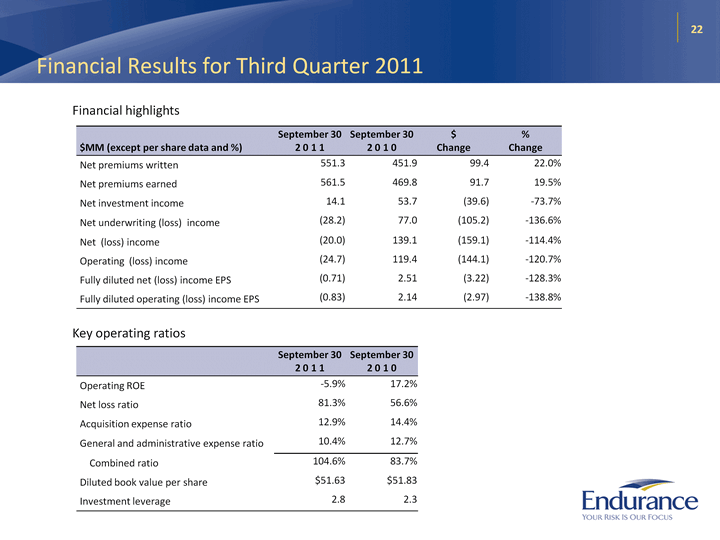
| 22 Financial Results for Third Quarter 2011 $MM (except per share data and %) September 30 2 0 1 1 September 302 0 1 0 $Change %Change Net premiums written 551.3 451.9 99.4 22.0% Net premiums earned 561.5 469.8 91.7 19.5% Net investment income 14.1 53.7 (39.6) -73.7% Net underwriting (loss) income (28.2) 77.0 (105.2) -136.6% Net (loss) income (20.0) 139.1 (159.1) -114.4% Operating (loss) income (24.7) 119.4 (144.1) -120.7% Fully diluted net (loss) income EPS (0.71) 2.51 (3.22) -128.3% Fully diluted operating (loss) income EPS (0.83) 2.14 (2.97) -138.8% Financial highlights September 302 0 1 1 September 302 0 1 0 Operating ROE -5.9% 17.2% Net loss ratio 81.3% 56.6% Acquisition expense ratio 12.9% 14.4% General and administrative expense ratio 10.4% 12.7% Combined ratio 104.6% 83.7% Diluted book value per share $51.63 $51.83 Investment leverage 2.8 2.3 Key operating ratios |

| 23 Third Quarter 2011 Net Written Premiums In $MM Sep. 302 0 1 1 Sep. 302 0 1 0 $Change %Change Property 17.7 21.4 -3.7 -17.3% Casualty 37.7 23.7 14.0 59.1% Healthcare liability 32.0 32.4 -0.4 -1.2% Workers' compensation 0.0 -0.8 0.8 -100.0% Agriculture 185.0 89.1 95.9 107.6% Professional lines 30.8 38.5 -7.7 -20.0% Total insurance 303.2 204.3 98.9 48.4% Insurance Segment In $MM Sep. 302 0 1 1 Sep. 302 0 1 0 $Change %Change Casualty 56.3 81.2 -24.9 -30.7% Property 129.2 111.4 17.8 16.0% Catastrophe 43.9 41.1 2.8 6.8% Aerospace and marine 6.0 4.2 1.8 42.9% Surety and other specialty 12.7 9.7 3.0 30.9% Total reinsurance 248.1 247.6 0.5 0.2% Reinsurance Segment |

| 24 Financial Overview: Historical In $MM 2002 2003 2004 2005 2006 2007 2008 2009 2010 YTD Sep. 30, 2011 2002 through 2011 Net premiums written 765 1,598 1,697 1,619 1,586 1,575 1,784 1,606 1,764 1,792 15,786 Net premiums earned 369 1,174 1,633 1,724 1,639 1,595 1,766 1,633 1,741 1,431 14,705 Net underwriting (loss) income 51 179 232 -410 304 322 111 265 195 -188 1,061 Net investment income 43 71 122 180 257 281 130 284 200 106 1,674 Net (loss) income before preferred dividend 102 263 356 -220 498 521 99 536 365 -66 2,454 Net (loss) income available to common shareholders 102 263 356 -223 483 506 83 521 349 -82 2,358 Diluted EPS $1.73 $4.00 $5.28 ($3.60) $6.73 $7.17 $1.31 $8.69 $6.38 ($2.07) $35.62 Financial highlights from 2002 through September 30, 2011 Key Operating Ratios 2002 2003 2004 2005 2006 2007 2008 2009 2010 YTD Sep. 30, 2011 Inception-to-date Combined ratio 86.2% 84.7% 85.8% 123.5% 81.5% 79.9% 93.5% 84.0% 88.7% 113.0% 92.7% Operating ROE 7.8% 17.3% 19.9% (11.9%) 25.7% 23.8% 8.5% 22.0% 12.6% (6.2%) 12.6% Book value per share $21.73 $24.03 $27.91 $23.17 $28.87 $35.05 $33.06 $44.61 $52.74 $51.63 |
